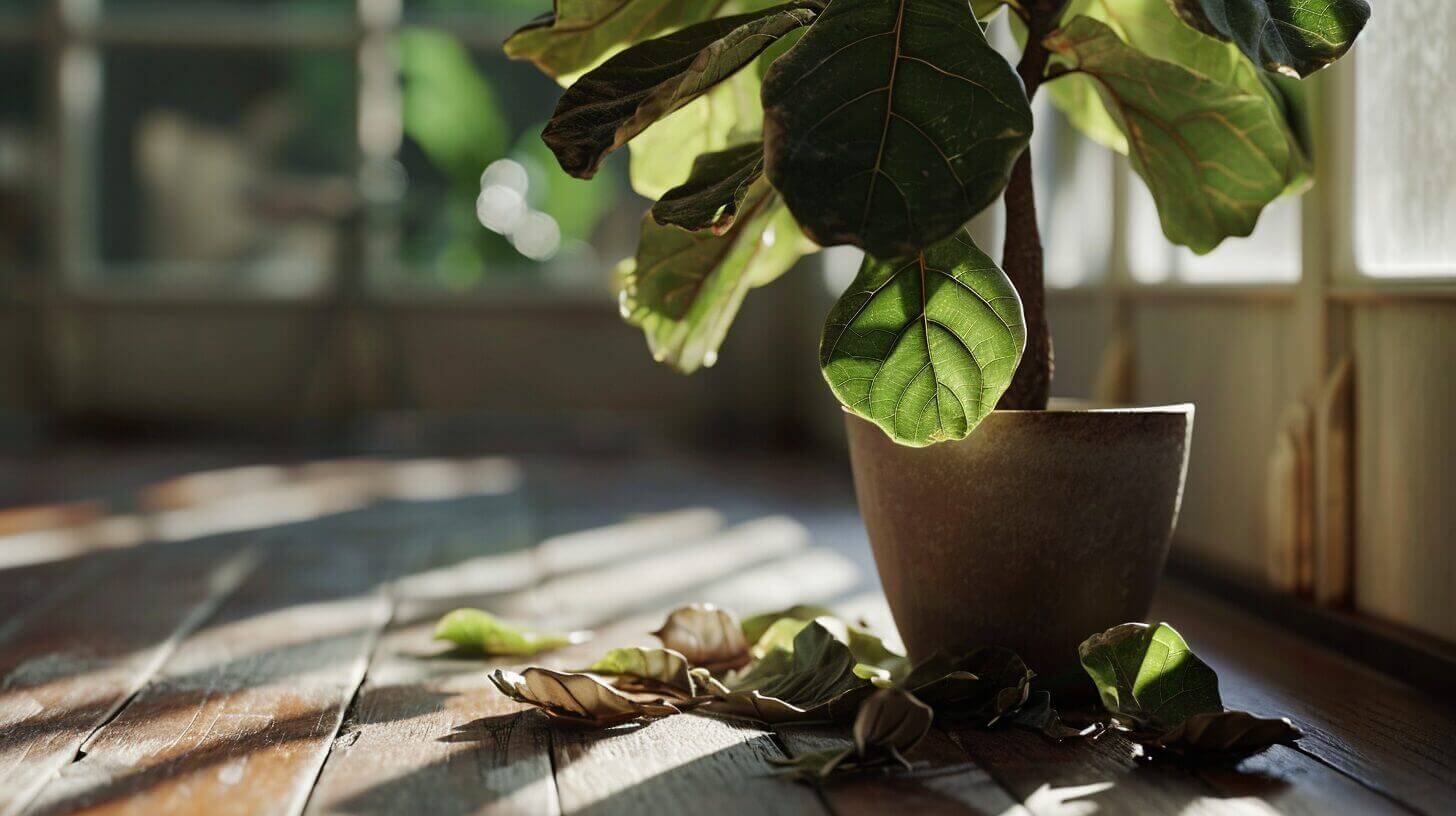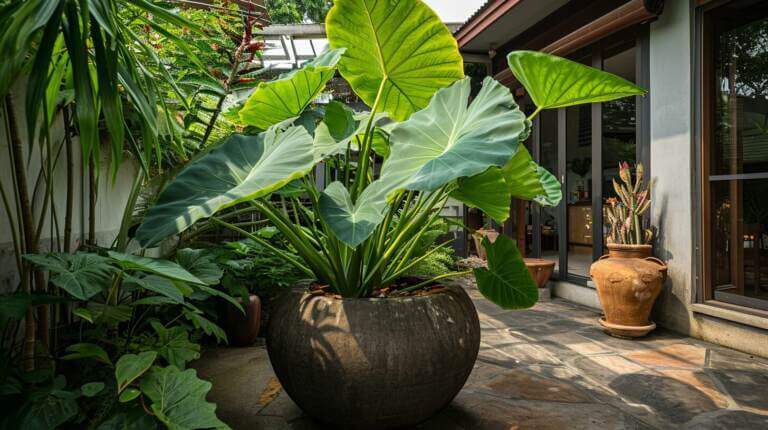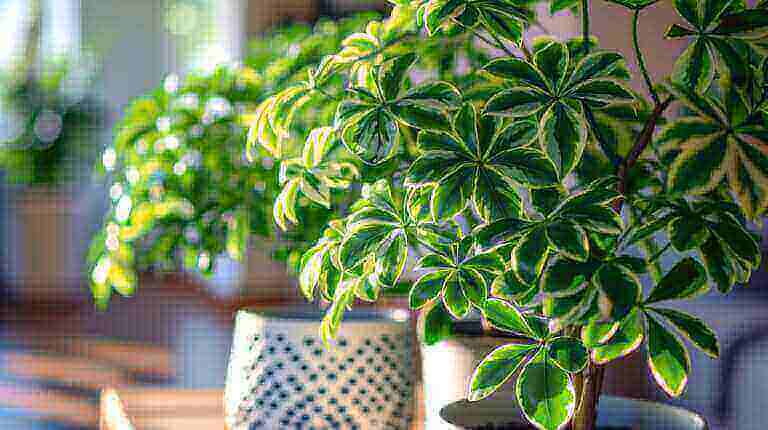Common Reasons Why Your Fiddle Leaf Fig is Dropping Leaves? Causes and Quick Fixes
One of the most common signs of trouble in a fiddle leaf fig tree is dropping leaves. Ficus plants, like the fiddle leaf fig, are prone to leaf loss when they are stressed. There are three main causes of leaf drop in a fiddle leaf fig: shock from being moved, dry conditions, and root rot. Shock can occur when a new fiddle leaf fig plant is moved and experiences a change in lighting and humidity. Dry conditions, such as lack of watering and dry air, can also cause a fiddle leaf fig to drop leaves. Root rot, often caused by overwatering and poor drainage, can lead to brown or black spots on the leaves and subsequent leaf drop. It is important to address the underlying cause of leaf drop and provide consistent care to help the fiddle leaf fig recover.
Key Takeaways:
- Leaf drop in a fiddle leaf fig can be caused by shock from being moved to a new environment.
- Fiddle leaf figs prefer consistency in lighting and humidity to prevent leaf drop.
- Provide a stable environment for your fiddle leaf fig to prevent leaf drop from shock.
Fiddle Leaf Fig Leaves Drop From Shock
One common cause of leaf drop in a fiddle leaf fig is shock from being moved. When a new fiddle leaf fig plant is transferred to a different environment with varying lighting and humidity levels, it can experience stress and drop older leaves near the middle and bottom of the plant. This leaf drop from shock is the plant’s way of reacting to the sudden change and adjusting to its new surroundings.
Fiddle leaf figs prefer a consistent environment, so any significant changes can prompt them to shed leaves. To minimize leaf drop from shock, it is crucial to provide a stable and suitable environment for your new fiddle leaf fig plant. Consider introducing it to your desired location gradually. Start by placing it in a bright greenhouse or a room with filtered sunlight. This will help the plant acclimate to higher light levels without causing a sudden change that could lead to leaf drop.
Leaf Drop From Shock: Summary
- Moving a fiddle leaf fig to a new environment with different lighting and humidity levels can cause leaf drop.
- New fiddle leaf fig plants may drop older leaves near the middle and bottom of the plant as a response to shock.
- Provide a stable environment by introducing the plant gradually and avoiding physical trauma during the moving process.
Fiddle Leaf Fig Dropping Leaves From Dry Conditions
One common cause of leaf drop in a fiddle leaf fig is dry conditions. Fiddle leaf figs require regular watering and do not tolerate dry air or direct sun. Overexposure to hot air or drafts can cause the leaves to turn brown and eventually drop. It is important to provide adequate humidity and avoid placing the plant near heating vents or in direct sunlight to prevent leaf drop from dry conditions.
To prevent leaf drop from dry conditions, it is essential to maintain a consistent watering schedule for your fiddle leaf fig. Water the plant once a week or when the top one or two inches of soil are dry. Avoid overwatering as it can lead to root rot, which is another common cause of leaf drop. Use a moisture meter to determine when your plant needs watering, ensuring that you provide enough moisture without drowning the roots.
| Causes of Leaf Drop from Dry Conditions | Prevention Tips |
|---|---|
| Lack of watering | Water the plant once a week or when the top one or two inches of soil are dry. Use a moisture meter to monitor the moisture levels. |
| Dry air | Avoid placing the plant near heating vents or in direct sunlight. Increase humidity by using a humidifier or placing a tray of water nearby. |
| Direct sun | Avoid exposing the plant to direct sunlight, as it can cause the leaves to dry out and turn brown. |
| Hot air and drafts | Ensure that the plant is located in a stable environment with consistent temperature and airflow. |
| Leaves turning brown | Monitor the plant closely for any signs of browning leaves, as it can be an indication of dry conditions. Take necessary measures to increase humidity and provide adequate watering. |
Fiddle Leaf Fig Is Dropping From Root Rot
One common cause of leaf drop in a fiddle leaf fig is root rot. Root rot can occur when the plant is overwatered and does not receive enough light. This can result in brown or black spots on the leaves and eventual leaf drop. To prevent root rot, it is important to check the drainage and lighting situation of your fiddle leaf fig.
Proper drainage is essential to prevent water from pooling around the roots and causing rot. Ensure that your fiddle leaf fig is potted in a container with drainage holes and use well-draining soil. If you suspect root rot, gently remove the plant from its pot and inspect the roots. Healthy roots are firm and white, while rotting roots will be mushy and brown.
| Causes of Leaf Drop from Root Rot | Prevention |
|---|---|
| Overwatering the plant | Ensure proper drainage by using a pot with drainage holes and well-draining soil |
| Poor lighting conditions | Place the plant in a bright location near a window, but avoid direct sunlight |
| Brown or black spots on leaves | Inspect the roots for signs of rot and take corrective action if necessary |
Healthy Fiddle Leaf Fig Tree Houseplant
To help your fiddle leaf fig recover from leaf drop and maintain its health, it is important to provide consistency in light, humidity, and watering habits. Keeping a consistent environment will help your plant thrive and reduce the risk of leaf drop.
Light
Place your fiddle leaf fig in a bright location without direct sunlight. Fiddle leaf figs prefer bright, filtered light, so a spot near a large window or in a bright room is ideal. Avoid placing your plant in areas with extreme temperature fluctuations or near heating vents, as this can stress the plant and lead to leaf drop.
Humidity
Fiddle leaf figs thrive in humid environments, so it’s important to provide adequate humidity for your plant. You can increase humidity by misting the leaves with water or placing a tray of water near the plant. Another option is to use a humidifier in the room where your fiddle leaf fig is located. Consistent humidity will help prevent leaf drop and keep your plant healthy.
Watering Habits
Water your fiddle leaf fig once a week or when the top one or two inches of soil are dry. It’s important not to overwater your plant, as this can lead to root rot and leaf drop. Using a moisture meter can help you determine when it’s time to water your plant. Insert the meter into the soil and water when the reading indicates the soil is dry. Providing consistent and proper watering will help your fiddle leaf fig stay healthy and prevent leaf drop.
| Light | Humidity | Watering Habits |
|---|---|---|
| Bright location without direct sunlight | Mist leaves or use a humidifier | Water once a week or when top inch of soil is dry |
| Avoid extreme temperature fluctuations | Place a tray of water near the plant | Use a moisture meter to determine when to water |
| Avoid placing near heating vents | Avoid overwatering to prevent root rot |
FAQ
Why is my fiddle leaf fig dropping leaves?
Fiddle leaf figs may drop their leaves due to overwatering, underwatering, low humidity, insufficient light, or sudden environmental changes. It is essential to identify the specific cause to address the issue effectively.
What are the common reasons why my fiddle leaf fig is losing leaves?
The common reasons for a fiddle leaf fig to lose leaves include overwatering, underwatering, low humidity, inadequate light, pest infestations, and root issues. Addressing these factors can help prevent further leaf loss.
How do I address brown spots on my fiddle leaf fig’s leaves?
Brown spots on fiddle leaf fig leaves may indicate issues such as overwatering, underwatering, or fungal infections. Adjusting the watering schedule, ensuring proper drainage, and using fungicidal treatments can help manage and prevent these brown spots.
When should I consider repotting my fiddle leaf fig?
Repot your fiddle leaf fig when its roots become overcrowded, the plant shows signs of nutrient deficiency, or the soil drainage becomes poor. Transplant the fiddle leaf fig into a slightly larger container with fresh, well-draining soil to support its growth.
Why are the lower leaves of my fiddle leaf fig turning yellow and drooping?
Yellowing and drooping of lower leaves in a fiddle leaf fig can be attributed to overwatering, root issues, nutrient deficiencies, or inadequate light. Address the underlying cause, adjust the watering practices, and provide proper nutrition and lighting to help the plant recover.
Will my fiddle leaf fig grow back its lost leaves?
If the underlying issues causing leaf drop are resolved, a fiddle leaf fig has the potential to grow back its lost leaves. Providing optimal growing conditions, nutrition, and care can encourage new leaf growth and overall plant recovery.
How can I identify if my fiddle leaf fig is underwatered?
Signs of an underwatered fiddle leaf fig include drooping or wilting leaves, dry and crispy leaf edges, and a generally parched appearance. Adjust the watering regimen to ensure the plant receives adequate moisture without being waterlogged.







